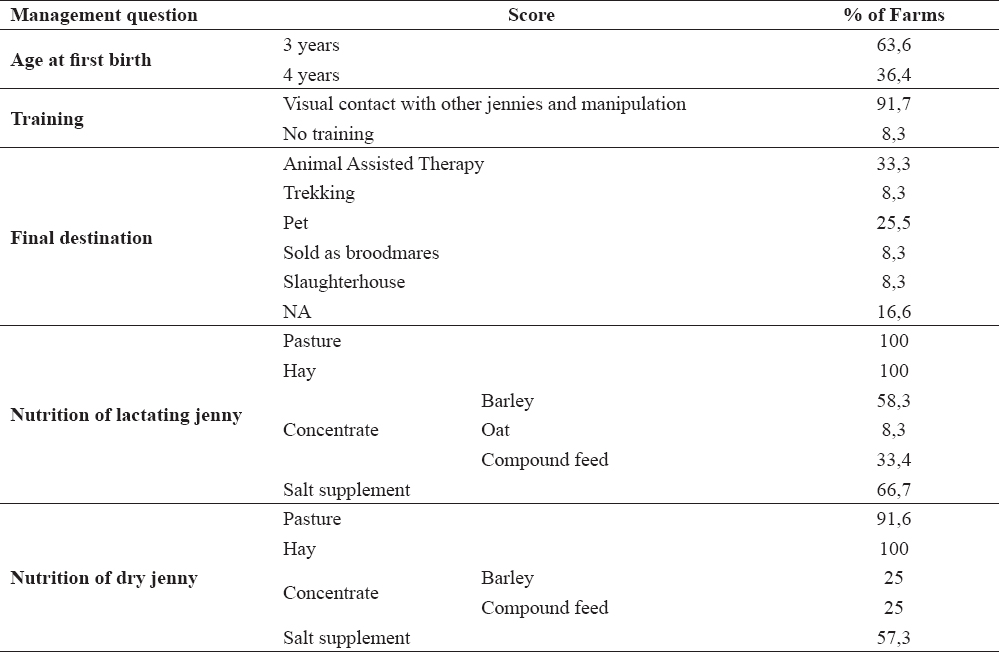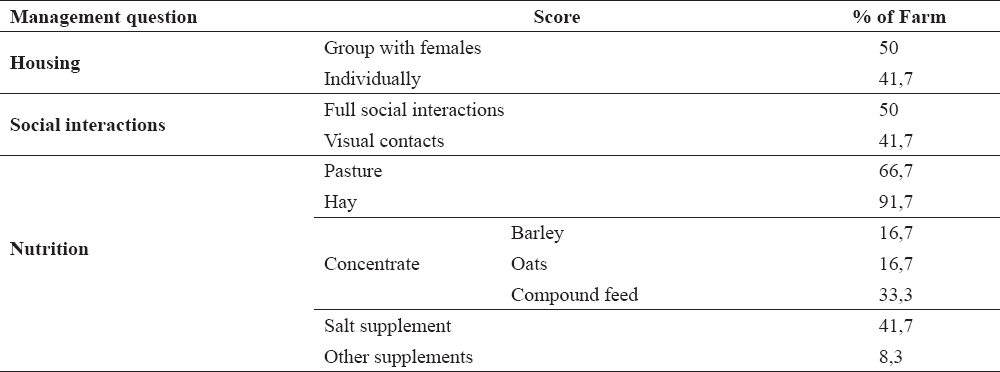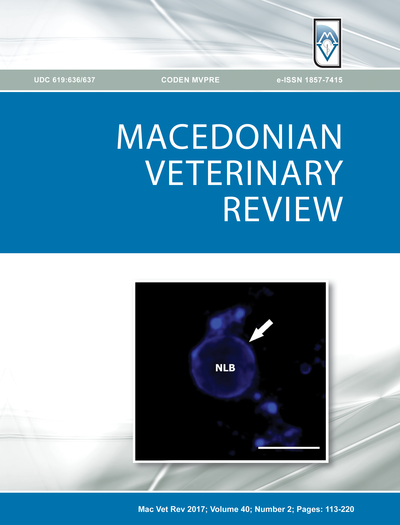INTRODUCTION
Thanks to the growing interest in donkey milk for paediatric nutrition (1, 2, 3) and cosmetics, a number of new small-scale donkey farms have opened in South Europe (4), mostly in Italy. The production systems adopted appear to differ hugely across farms, ranging from semi-intensive to semi-extensive systems. Limited information is available about the management characteristics of these farms and preliminary investigations (5) have highlighted a number of potential issues relating to the management and the welfare of dairy donkeys (6). The aim of the present study is to collect data regarding dairy donkey management and milk production in farms distributed over the Italian territory.
MATERIAL AND METHODS
Farms
Twelve dairy donkey farms, selected with a blocked randomization process matched for the North-Centre-South parts of Italy, were visited between June and September 2015. The selected regions were Lombardia, Abruzzo and Sicilia. Local authorities provided the contact details of dairy donkey farmers in their area. Farmers were contacted over the phone or by e-mail by researchers to introduce the project and to plan an on-farm visit. All the contacted farmers participated on a voluntary basis. The number of donkeys per farm varied between 19 and 170 (mean=54,50±47,86).
Questionnaires
Farmers were asked to fill out two questionnaires: the first one on the animal management and the second on milk production. The animal management questionnaire contained questions about nutrition, health management, housing, final destination of donkeys and foals (e.g. pet, work, meat production), weaning methods, management of male donkeys intended for meat production and distances travelled to reach slaughter. The questionnaire on milk production contained questions about average milk production per farm, use of milk (e.g. human consumption, cosmetics, processing into other food products such as ice-cream or sweets), sales channels (e.g. on the farm, consortium, supermarket, independent store, specialist or non-specialist store, restaurant, other), terms of sale (e.g. fresh raw milk, pasteurized milk, frozen milk, lyophilized milk), methods to reduce bacteria, marketing channels and consumers’ characteristics.
Following the method adopted in (7) to evaluate the welfare of donkeys kept for different purposes, the AWIN welfare assessment protocol for donkeys (8) was used, in the present study to evaluate the welfare of dairy donkeys. Results of the welfare assessment were partially published in (6).
Data collection and data analysis
Data was collected using Open Data Kit application (developed by the University of Washington, Department of Computer Science and Engineering), a digitalized system available for Android devices (9). Data was downloaded from the server to a Microsoft Excel file (Microsoft Corporation 2010) and subsequently descriptive statistical analysis were performed with SPPS 22 statistical package (IBM SPSS Statistic 2013).
RESULTS
Animal management questionnaire
The number of donkeys per farm varied from 19 to 170 donkeys (mean 54,50±47,86). Of a total of 244 females, 120 were lactating and 124 were dry jennies, aged between 36 and 288 months (mean=88,87). A total of 27 stallions, aged between 24 and 180 months (mean=90,46), lived on the visited farms; one farm had no stallions, since they shared it with another farm. Most of the farms (N=6) had mixed breed donkeys, while the remaining ones kept only one breed (e.g. Grigio Siciliano, Sardo, Martina Franca, Ragusana and Amiata). Donkeys were usually kept semi-extensively (pasture with shelters) all day long, with the exception of two farms where they were stabled during the night. Shelters were not present on three farms. Except for three farms where donkeys were kept all together, animals were grouped according to their production characteristics: in particular, lactating and dry jennies were usually separated to better manage feeding and milking procedures. Results of jennies and stallions management are reported in Table 1 and Table 2, respectively.
Table 1. Management of jennies
Table 2. Management of stallions
A total of 169 foals (102 female and 67 male) were present on the assessed farms. No farms used artificial milk, therefore, the foals received colostrum from and were nursed by their mother until 6-12 months old (mean=8,83±2,12). Additional feed was introduced between 0 and 12 months (mean=6,58±3,85). The weaning process differed from farm to farm: on five farms foals remained with their mother after weaning and were not separated; on two farms foals were weaned one at a time, starting with the oldest, which created a new group of yearlings on the farm; on the remaining farms (N=5), one jenny was taken away at a time letting the group settle down again until the next jenny was removed. Donkeys were milked on 11 of 12 farms. For the milking procedures, foals were separated from their mothers four (N=3), six (N=5) or 12 hours (N=3) before milking. During the separation period, foals were usually housed in paddocks near their mothers (N=10), with the possibility of visual and/or tactile contact. In the remaining farm, foals were totally separated from their mothers with no visual or tactile contact possible. Male foals not intended for reproduction were sold directly to the slaughterhouse (N=6), to other farms where they were going to be used for assisted therapy (N=3) or to private owners as pets (N=2). The remaining farm adopted all the possibilities mentioned above. Foals were sold between three and 18 months (mean=10,42±3,73).
Most of the visited farms (N=10) were family run, only two farms had employees. The number of donkeys cared for by a single person varied from five to 103 animals (mean=38,33±33,19). Night care was guaranteed on 10 farms. The veterinarian was called every month for routine checks by three farmers, while the other farmers called the vet only when needed. Vaccinations were regularly performed only on two farms; most (N=10) of the interviewed farmers did not consider vaccinations useful for the health of donkeys. Nine farmers regularly dewormed young and adult donkeys, one farm dewormed just foals and only two farmers did not consider it necessary to deworm animals. Two farmers called the farrier every three months, six farmers less frequently, while four farmers never called the farrier. Most of the farmers declared that they had the ability to perform hoof correction autonomously.
Milk production questionnaire
Eleven farms produced donkey milk for sale (mean milk production per jenny/day was 1355±509 ml); the remaining farm was brand new and it was not yet producing nor selling milk. Milk was intended for human consumption (N=11), eight farms also produced cosmetics and four additionally transformed milk into confectionery products. The main sales channel was direct to the consumer (N=11), other options were a small consortium (N=1) and a non-specialised shop (N=1). The marketing channels were websites and social networks (N=8) and word of mouth (N=8). None of the sampled farms sold milk to paediatric wards. Consumers mostly bought fresh milk directly on farm more than once a week (N=5) or less frequently (N=6). The answers to the question “what influences consumers’ purchasing decisions?” were rather vague and in most cases could be interpreted as the need to drink donkey milk because of health reasons. All the consumers, as reported by farmers, were children in the household. All the farms but one performed mechanical milking, the remaining one did manual milking; machines used were modified from a goat milkmaid. Nine farms milked once a day, the remaining one milked upon request. All the farmers adopted a method of cleaning and disinfection of the teats: damp cloth, disinfectant or pre-dipping. Five farms performed pasteurization, four refrigerated the milk, one farm performed filtering and one farm froze the milk. All the farms but one periodically carried out milk analysis, with eight farms searching for somatic cells (22916,7±34851,5 SSC/ml) in addition to bacterial count (134166,7±229383,3 cfu/ml). All the farmers declared not to use any drugs on lactating donkeys. It remains to be investigated if and how lactating donkeys were treated when ill.
DISCUSSION
The findings of the present study show that the assessed Italian dairy donkey farms do not follow uniform procedures for the management of animals (nutrition, stallion keeping, mother-foals separation and health care) nor milk production.
Considerable differences between farms were found in concentrate feed of both dry and lactating jennies, e.g. feedstuffs and amount of feed per day. As already highlighted by several authors (10, 11, 12, 13), these differences could be interpreted in the light of the lack of scientific knowledge on donkey nutrition in different physiological states, such as lactating or pregnant jennies. On average, the assessed animals enjoyed a good nutritional status (with 80.2% of the donkeys having a Body Condition Score of 3 on a 5-point scale), however dry jennies and stallions seem to require more attention regarding their nutrition (6). In the assessed sample, stallions were often singly stabled, meaning that they enjoyed only visual contact with other donkeys. It is well known that donkeys are highly social animals (14, 15); thus contact with other conspecifics plays an important role in maintaining them in good welfare condition. Furthermore, Dai et al. (6) reported that stallions kept in single boxes have less possibility to move freely, thus increasing the frequency of hoof problems. In the visited farms, daily milking number, frequency as well as the duration of mother-foals separation before milking varied based on farmer’s personal experience. D’Alessandro and Martemucci (16) reported that the daily milking regimen influences the milk yield and the udder health condition. Furthermore, 3 hours was described as the ideal interval milking to obtain the best organoleptic characteristics of donkey milk (17). In the same study, intervals of 5 and 8 hours were found to cause a decrease in milk fat and lactose content. Moreover, donkeys are considered a follower species, which like to keep their foals nearby until 10 months of age (18). It is likely that the separation between jenny and foal is stressful and the duration of this period can play a crucial role. For this reason, farmers kept the foals in a group and in visual contact with their mothers. However, further studies are needed to better understand the effect of milking intervals (4, 6 and 12 hours) not only on milk characteristics, but also on the behaviour of the animals. In terms of health care, different approaches were followed and the need for more uniform procedures is clear: as donkey milk is mainly consumed by allergic infants and children, ensuring high standards of animal health is of paramount importance. Prevention being better than cure, all donkeys involved in milk production should have routine veterinary checks, deworming programmes and regular vaccination schedules (19, 20). Regular health checks have been shown to have a demonstrable impact on both welfare and productivity of the donkeys (21).
Milk is sold raw, refrigerated, frozen, pasteurized or lyophilized and it is not unusual that milk processing methods differ from farm to farm, depending on the farm area. It is recognised that only few Regions adopt a specific legislation for producing and selling donkey milk (5, 22, 23). Furthermore, little information is available on the best solutions for donkey milk processing (24, 25, 26) and more studies are needed to clarify how these procedures modify milk properties in terms of nutritional value, food safety, and organoleptic characteristics.
CONCLUSION
To date, this was the first study investigating different aspects of donkey milk production. Even though the sample of dairy donkey farms assessed was small, considerable differences were found in management and milk processing. These differences are likely due to the lack of uniform information available for the farmer. The adoption of scientific based procedures in both management of donkeys and milk processing is suggested in order to improve both animal welfare and milk quality raising the consumer trust in this niche product.
CONFLICT OF INTEREST STATEMENT
The authors declared that they have no potential conflict of interest with respect to the authorship and/or publication of this article








